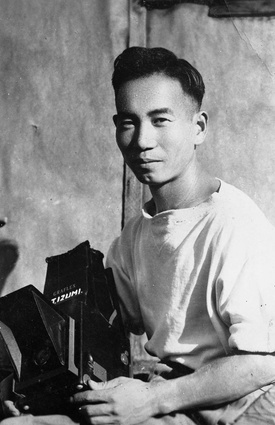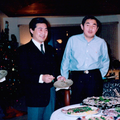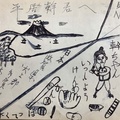
Basil Tadashi Izumi was born April 25, 1937, in Vancouver General Hospital. He was delivered by Dr. H. M. Shimokura, who later would earn the trust of Japanese Canadians by his treatment of numerous patients in the harsh conditions of Hastings Park and then at Tashme internment camp. Basil has two younger sisters, both of whom were born during the internment. The first, Megumi Grace, was born on April 22, 1944, in New Denver hospital, and the second, Emiko, on August 6, 1945, in Lemon Creek. Basil remembers her being taken to the closest hospital, which was in Slocan.
Basil’s mother, May Ume Shiga, was born in Vancouver in 1915. Her parents were from Kochi Prefecture on the island of Shikoku in western Japan. Her mother was from Samurai stock, and her father was a farmer. Basil is not sure precisely when his mother’s parents came to Canada, but it was sometime between 1910 and 1912. They were already married and had one child, a son, when they arrived. It is also unclear exactly why they came to Canada. Basil was told by an aunt that some family members had also gone to Brazil, but was not given any details of exactly when or why they went.
He doesn’t know what kind of work his mother’s parents did when they first arrived in Canada, but eventually they were living in the Powell Street area in east Vancouver where many Japanese immigrants had settled. Her father became a janitor in the nearby Holy Cross Anglican Mission and her mother played the piano there. They learned to speak English to some degree although not very fluently. Basil remembers talking to his grandmother in English and her answering back in Japanese.
Basil’s father, Tadao John Izumi, was born in 1910 in Shimasato, a small coastal village in Wakayama.1 His parents owned land near Shimasato and did small scale farming. He came to Canada by himself when he was nineteen, but he had a friend from the same village, James Shingo Murakami,2 who had previously gone to Vancouver and was working there as a photographer. Basil does not know why his father decided to leave Japan and go to Canada (“I never asked and he never said”), but thinks it was most likely to improve his economic standing, as was the case with many of those who emigrated from Japan at that time. He speculates that it might also have been partly due to his keen sense of adventure.
Although the details are unknown, Basil’s mother’s parents converted to Christianity and were baptized in the Holy Cross Anglican Mission soon after coming to Canada, so his mother was born into an Anglican family. The conversion of Basil’s father occurred after he had been invited to the Holy Cross Mission by his friend, Shingo Murakami, who was already a member there. Basil speculates that his parents probably met at one of the Anglican mission activities as they were both active members and the mission played a central role in their lives.
Basil’s Family and Their Life in Vancouver before Uprooting and Incarceration
As far as Basil knows, his father did not go to school after arriving in Canada but rather immediately began working. His first job was fishing for Celtic Cannery. This work did not go well, so he started to look around for photography work, asking for help from his photographer friend Shingo Murakami. Shingo did not hire Basil’s father himself but instead directed him to Campbell Studio. He was hired by the owner, Mr. Campbell, who was very friendly and taught him photography.
Basil’s mother, having been born in Vancouver, was educated in the public school system from elementary school on. He doesn’t know whether she attended an Anglican kindergarten. He assumes she got a good education and finished high school due to the fact that later on, after the family was exiled to Japan, she was immediately able to get a good job with the American occupation forces.
Basil’s parents lived in various places during their time in Vancouver including Powell Street, Cordova Street, and Nelson Street (east of Granville). It appears that they generally enjoyed their life within the Japanese Canadian community in Vancouver, and there are photos of both of them happily pushing Basil around in the baby stroller.
As far as he can recall, they had a good family life, and they had a lot of friends. His father’s friends often came to their home to visit, and his parents also played active roles in the church and participated in church social activities such as picnics and home Bible studies as portrayed in several photos of them with church groups.
Basil attended Sunday school and kindergarten at the Holy Cross Mission. Naturally he doesn’t remember many details from this period, but does recall commuting by streetcar to kindergarten and has one particularly pleasant memory of meeting his kindergarten teacher (and godmother), Miss Margaret Foster while going to the kindergarten on the streetcar. Although he has several pictures of his kindergarten classmates, he does not remember them by name as he never got to see them again after they were uprooted from Vancouver.
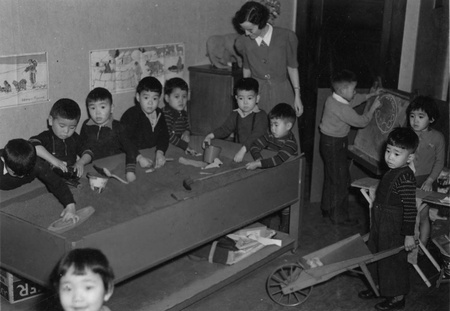
He also has memories of playing with some South Asian children in his neighborhood. Specifically, he recalls eating “with gusto” a spicy snack they offered him. Apparently, the resulting spicy odor on his breath so shocked his mother that she washed out his mouth.
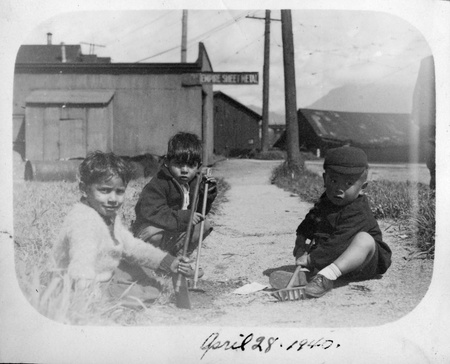
He doesn’t recall his family experiencing economic hardship or shortages in Vancouver, nor does he have any recollection of them facing overt racial discrimination, perhaps because they tended to stay mostly within the Japanese Canadian community. As he was very young at this time, he doesn’t recall ever noticing the problems the adults were facing.
Notes:
1. Shimasato is located quite far from Mio Village (where most of the Wakayama immigrants originated) but very near a traditional whaling village called Taiji, which has become internationally famous and controversial in recent years due to its annual dolphin hunt.
2. For a concise bio of Japanese Canadian photographer James Shingo Murakami, see Postview: The Newsletter of the Vancouver Postcard Club, December, 2011, p. 5. Accessed September 17, 2017.
* This series is an abridged version of the original article titled, “A Japanese Canadian Child-Exile: The Life History of Basil Izumi,” originally published in The Journal of the Institute for Language and Culture, Konan University, Vol. 22, pp. 71-108 (March 2018).
© 2018 Stanley Kirk


